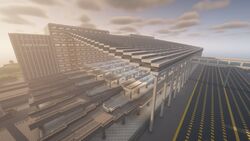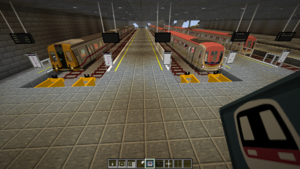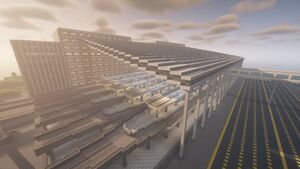Misato Station
Views
Actions
Namespaces
Variants
Tools
| Location | 1552 ~ 31943 |
|---|---|
| Owned by | Harmony Rail Transit (Lamtsu) |
| Operated by | Harmony Rail Transit (Lamtsu) Misato Rapid Transit Kabuki Kaisha (MRT Corp) |
| Line(s) | Yamate Line Mihara Line |
| Platforms | 13 |
| Tracks | 13 |
| Connections | MRT Misato Station Misato Light Rail Stop |
| Structure Type | At-Grade+Elevated |
|---|---|
| Platform Levels | 3 |
| Disabled Access | No |
| Station Code | MS |
|---|
| Opened | 30 June 1947 (Initial Opening)
1st May 2022 (Heritage Platforms) 30 June 2022 (Full Reopening) |
|---|---|
| Closed | 31st Jan 2022 (Reconstruction) |
Misato Station is a HRT (Lamtsu) station in Misato City, Lamtsu Capital City, Hon Kwong Province, Empire of Sorano. The Station was the most important station in the HRT Network in Lamtsu, being the primary terminus for long-distance lines to Joban and South-East Sorano. It was also the 3nd busiest Station in the Joban-Sorano Region, with more than 700,000 commuters using the station in June 2016. The station was closed for reconstruction after the HRT (Lamtsu) scandals that followed the 2022 Sora train wreck, with many of the Main Lines being rerouted away from the station and the Kansai Main Line being split off to the MRT Corporation.
History
Conception
Misato Station was originally conceived as the terminus of the Yamate Line in 1946. However, pressure from the local government forced the extension of the Line to Hikawa, delaying its opening by a year. The original station was constructed at-grade, with the Yamate Line platforms adjacent to Misato Hill.
Further Expansion
With the opening of the Namboku Line in 1968 and the Completion of the Kujukuri-Sakuho Line in 1975, Misato Station replaced Lamtsu station as the de facto primary interchange. however, Misato City Railway maintained that Lamstu station was the main terminus, making it the de jure interchange and therefore received the bulk of the funding. This resulted in the infrastructure of Misato Station being very lacking.
Subsequent platforms were built on a separate station building and elevated, for the terminating 4-car lines on ground level. However, the lack of funding and the prohibitive land costs in Misato prompted the platform width to be reduced from the 10m standard on the Yamate Line to 5 metres for the elevated platforms. By 2015, Misato Station was severely overcrowded, with reports of suffocations due to lack of platform space being not uncommon. This was further exasperated due to the cross-platform transfers between the Mihara and Namboku lines, where crowds of passengers would often crush each other in an attempt to squeeze onto the trains. By this time, almost every line would pass through or terminate at Misato, excluding the Tozai Line and the Chuo Main Line. As the Chuo Main Line was built by HRT and not Misato City Railway (Now MRT), the Line was prohibited from cutting across the Yamate Line and the decision was made for it to terminate at Otaki, with some services continuing to Fukaaura.
2022 Sora Train Wreck
The 2022 Sora Train wreck was the worst train accident in all of Sorano, with 78 fatalities and more than 600 injured. The train involved was a Ome Liner limited express on the stretch between Sora and Misato.
Preliminary investigations show that the train was travelling at 120km/h over a 60km/h stretch, and as such the train derailed and broke apart while approaching the bend towards Misato station.
The driver was most likely trying to make up for lost time that had occurred when he overran the platform at Mihara, causing the train to be delayed by 5 minutes, and then delayed again because he was slowed down by a Vtuber Park Line Local train also travelling to Misato. The extremely old and curvy tracks on the lines in Lamtsu had been a severe issue for quite a while, with a 2018 report highly recommending the rebuilding of the old lines. However, these warnings were ignored and the speed limits on the lines were in some parts, cranked up all the way to 160km/h on what should have been a 100km section at the maximum.
The accident triggered an investigation that found HRT (Lamtsu) guilty of negligence and filed an antitrust lawsuit, splitting the company into 3. This also caused the 2022 Great Lamtsu Railway Rebuild, a period of 8 months without train service where the railways were being rebuilt.
2022 Misato Station Rebuild
In the aftermath of the Sora Train Wreck, HRT Lamtsu had a revision of the railroad doctrine, and the decision was made to spread out the terminals of the lines along the Yamate Line rather than concentrating them all along Misato station. The Vtuber Park Line was moved to Kimotsuki, and the Kansai Main Line was moved to MRT Misato station across the road. Tram operations also were moved to terminate at the new Misato Tram terminal.
Misato's old stone-brick design, while nostalgic, was not kept in the rebuild. Misato station was completely transformed from an overcrowded dinky station to a modern, futuristic station. The Engineer and Architect of the station was subsequently put in charge of the Lamtsu Railways. However, despite this amount of responsibility, he was still officially a minor employee and thus drew a very low salary, leading to accusations at HRT of Black Company behavior.
Design
Misato Station is a modernist style, with a huge roof covering 5 Island platforms, with the concourse at ground level. An elevated linkway above the platforms connects them directly to the opposite side of Misato High Street, as well as Misato Central Mall and MRT Misato station. On the map, the colour of the station is grey, but the colour scheme of the area is much more light-blue. The concourse preserves the older andesite grey colour scheme, while the floor of the concourse is a tiled pattern alternating Polished Diorite and Calcite. On the North-West of the station, there is a heritage area in the style of the old Misato Station for the heritage Ome Line. The Sakuho-Kujukuri Line platforms retain their old design.
The old Misato Station was very much brutalist architecture, with the station constructed of mostly Stone Brick, Andesite, and the occasional Iron Support.
2021 Platform Layout
| B1 | |
| 21: Sakuho Line for Kamiyama (From the Kujukuri Line)→ | |
| Island Platform (To Concourse) | |
| ←22: Kujukuri Line for Tsubetsu (from the Sakuho Line) |
| G (Indoors) | |
| Side Platform | |
| 1: Ome Line (Urban) | |
| 2: Ome Line (Rapid) | |
| Island platform | |
| 3: Ome Liner | |
| 4: Ai Liner | |
| Island Platform | |
| 5. Vtuber Park Line | |
| 6. Kansai Main Line (Local) | |
| Island Platform | |
| 7. Kansai Main Line (Rapid) | |
| 8. Kansai Main Line (Express) | |
| Island Platform | |
| 9. Kansai Main Line (Urban) | |
| 10. Tohoku Liner | |
| Side Platform |
| G | |
| 19. Yamate Line (Soto-Mawari)→ | |
| Island Platform | |
| 20. ←Yamate Line (Uchi-Mawari) |
| L1 | |
| Side Platform | |
| 11. Mihara Line for Hayakawa→ | |
| 12: Mihara Line for Tai Hing→ | |
| Island Platform | |
| 13. Namboku Line for Hayakawa→ | |
| Island Platform | |
| 14. Mihara Line for Mihara→ | |
| ←15. Mihara Line for Yamate | |
| Island Platform | |
| ←16. Namboku Line for Meguro | |
| Island platform | |
| ←17. Mihara Line for Lamtsu | |
| ←18. Mihara Line for Lamtsu | |
| Side Platform (Connect to Yamate Line) |



